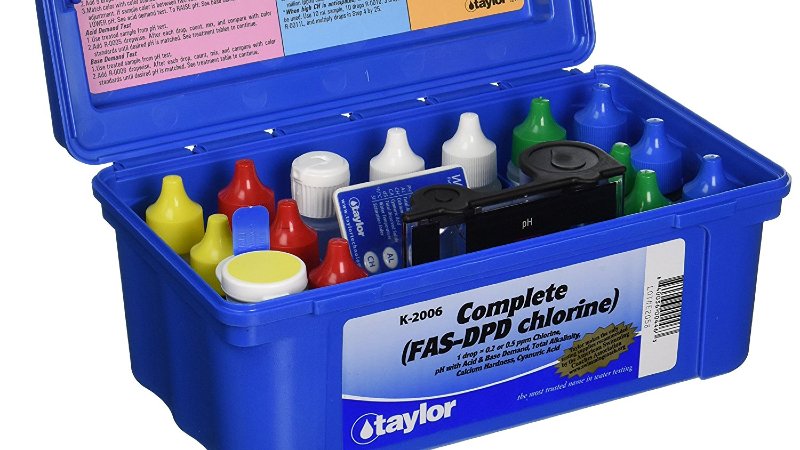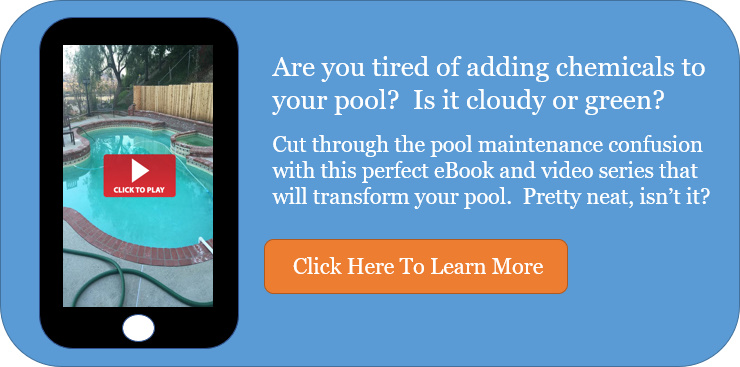How To Lower Your Pool pH Using Acid
When our pool chemistry levels are perfect, life is good. But what happens if they're not in line? We need to get them back, and our pool pH level is certainly no exception. When our pH level is too high or low it can throw everything else out of balance, especially our chlorine's effectiveness.
There are a few quick ways to can reduce your pool pH and it only takes a few minutes.
What Does pH Stand For?
The definition of pH is the negative log of hydrogen ion concentration in a water-based solution. It's an abbreviation for "power of hydrogen". It has a range of 0 - 14 and 7.0 is neutral. Anything 6.9 and under is acidic and 7.1 and over is alkaline, or basic.
What's The Correct Range Of My Pool pH?
Most textbooks will tell you the optimal range for your pool pH is a very narrow 7.4 - 7.6. In my opinion and over 20 years of experience, this is too narrow and very difficult to control. Your pool pH is pretty forgiving, so you can plan on shooting for 7.2 - 7.8. This way your chlorine will still be effective and you're not stressed out over a simple 0.2 variation.
Why Should I Lower My Pool's pH Balance?
Our pool chemistry has ranges, and we should do our best to maintain the chemicals within those ranges. When things are out of range, too high or low, they can cause problems. When our pool pH level is 5.5, the chlorine is 100% effective. At around 7.2-7.4 the chlorine is about 50% effective. At a higher pool water pH of 8.0-8.2 and above, the chlorine's effectiveness drops to 25%.
By keeping our pH level between 8.0 or higher, we're actually wasting almost 75% of our chlorine!! On the flip side, at 7.0, you'll use too much pool acid, but the chlorine is a bit more effective. Also, high sustained pH levels coupled with high sustained calcium hardness can lead to scaling and calcification of pool heaters and chlorine generators.
Why Is My Pool pH Level High?
The pH in water will naturally rise through the result of bather load, splashing around, using water features such as waterfalls and slides, and salt pools that use chlorine generators. Shocking your pool with calcium hypochlorite can also lead to high pH levels. The process of the pH increasing through water movement is called "out-gassing" or aeration. When a swimming pool is unbalanced, out of control, and doesn't have the proper pool water chemistry, it can be the most frustrating time for a pool owner.
The occasional fluctuation in your pool pH is nothing to be concerned about. Things go up and down all the time. It's the high and sustained pH level that we need to watch, and take the appropriate measures to bring the level down to their respective range.
How To Lower Your Pool pH Level Using Dry Acid
There are 2 products that do a very good job at lowering your pool pH and they are muriatic acid and dry acid, sometimes called sodium bisulfate. I love using dry acid. Its benefits are enormous such as easy to add to your pool, easy to store, cost effective, and if you spill a little one your deck, no worries. It won't stain your deck like muriatic acid, so just sweep it up and you're done.
To lower your pool pH, you will need:
- Gloves and goggles.
- Grungy long pants and shirt.
- Dry acid.
- Dedicated measuring cup.
- 4 or 5 gallon bucket.
- Dedicated stir stick. PVC pipe works great.
1. Put On Your Protective Clothing and Gear
Even though dry acid is great, it's still acid, so we're going to take the right precautions. Let's dress for success.
2. Test Your Pool pH and Alkalinity Level
Your pH should be 7.2 - 7.8 and your alkalinity should be 80 - 120 ppm. If your pH level is too high, it's time to lower it.
3. Fill Your Bucket With Pool Water
Dip your bucket into the pool and fill it 1/2 - 2/3 up with pool water.
4. Measure Out The Right Amount
Using your dedicated measuring cup, measure out the amount of acid you'll need. Go to the Pool Calculator for the amount.
5. Add The Dry Acid To The Bucket
Always add the chemical to the water, never the water to the chemical.
6. Mix With Your Dedicated Stir Stick
Grab your PVC pipe, or whatever you've chosen as your stir stick, and gently mix the chemical in the water filled bucket.
7. Add To Pool
Carefully, and starting in the deepest part of the pool, add the mixture around the perimeter of the pool.
8. Sweep Your Pool
Sweep after adding your dry acid. This will ensure the acid will get circulated in the water and won't allow it to settle to the bottom of the pool and possibly cause a chemical stain.
9. Turn The Pump Motor On and Circulate The Water
Adding chemicals is systemic, meaning, the chemical must go through the entire system before testing. You will want to test your pool pH level after 8 - 10 hours and make another adjustment if needed to get your pH in the correct range of 7.2 - 7.8.
How To Lower Your Pool pH Level Using Muriatic Acid
Lowering pH in our pools is a little different using liquid, or muriatic acid. This is one of the most caustic acids on the market and extreme care should be taken when using and handling it. Always follow the manufacturer's recommended safety instructions.
1. Put On Your Protective Clothing and Gear
We're dealing with acid so let's take the right precautions and dress for the occasion.
2. Test Your Pool pH and Alkalinity Level
Our pH should be 7.2 - 7.8 and our alkalinity should be 80 - 120 ppm. If the pH level is to high, it's time to lower it.
3. Fill The Bucket With Pool Water
Fill your bucket to 1/2 - 2/3 with pool water.
4. Measure Out The Right Amount
Measure out the correct amount of muriatic acid you'll need. I suggest using a dedicated glass measuring cup. Go to the Pool Calculator for the amount you'll need.
5. Add The Muriatic Acid To The Bucket
Always add the chemical to the water, never the water to the chemical.
6. Mix With Your Dedicated Stir Stick
Gently mix the chemical in the water filled bucket.
7. Add To Pool
Carefully, and starting in the deepest part of the pool, walk the mixture around the perimeter of the pool.
8. Sweep Your Pool
Sweep well after adding your muriatic acid.
9. Turn The Pump Motor On and Circulate The Water
The muriatic acid must go through the entire system before testing. You will want to test your pool pH level after 8 - 10 hours of filtering and make another adjustment if needed to get your pool pH level in the correct range of 7.2 - 7.8.
How Do I Keep My Pool pH Level Balanced?
There are several things you can do to help keep your pool pH level in the right range, and you'll see immediate results.
1. Test My Chemicals
This cannot be overstated enough. We must test to know where our chemical levels are. Only after this can we know if our chemicals are in or out of range.
2. Limit Products That Cause Pool pH To Rise
Over-use of products like pH Increaser, baking soda, soda ash, and Arm & Hammer Washing Soda can all contribute to increasing pH levels.
3. Keep Your Pool Clean
Sweeping and vacuuming is essential to having a clean pool and will assist in keeping your chemical levels in check.
4. Maintain Your Filter
We will never clean dirty water with a dirty filter. Keeping our filter clean will ensure safe and clean water.
How To Become pH Level Pro
The best thing we can do to keep our pools cleaned and well-maintained is by learning and staying on schedule. This will certainly decrease the amount of future problems. When problems arise, you'll be armed with the knowledge and expertise to tackle them.
What Other Visitors Have Said
Click below to see contributions from other visitors to this page...
I Can't Get The pH Up In My Pool Not rated yet
I Can't Get The pH Up In My Pool
by Liz
(South Africa)
I have recently purchased a house and trying to figure out how to balance the pool. It is …
High PH and High TA Not rated yet
High PH and High TA
by Arctic Frost
(Arizona)
I see many questions about high pH and low TA but what about high pH and high TA? I've added pH minus …
Soda Ash Overdose Not rated yet
I overdid my 14 foot above-ground pool on soda ash to raise the pH and overall alkalinity, and now I can’t see anything beyond the top.
I treated it …
Staining And Trying To Raise pH Not rated yet
I have a 40,000 gallon vinyl lined inground pool. I am having a few issues that I am trying to resolve.
Cl levels are 2-4 ppm. I just addded 26 lbs …

